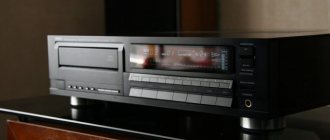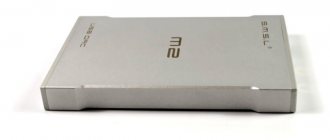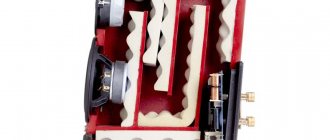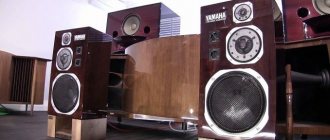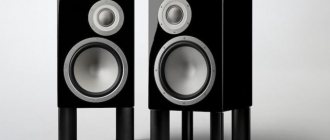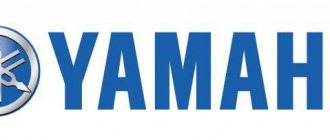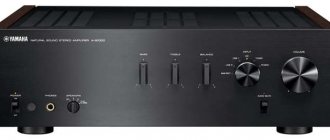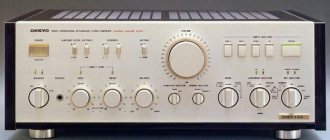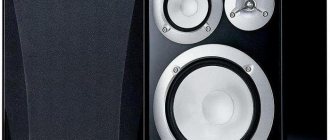Yamaha NP-S303 Network Player
It's an honor to be the first. Pioneers get laurels, but ripe fruits go to those who were not in a hurry and chose the right moment. For example, network audio equipment has been produced for a long time, so the Yamaha NP-S2000 Hi-Fi player, released in 2010, was not the first, but it was the one that “pushed” network players from the top floor of custom installations to the level of ordinary components. It seemed to us that the new Yamaha NP-S303 model has a chance to repeat this feat.
To understand what impact Yamaha's new streamer can have on the market, let's go back to the time when the Yamaha NP-S2000 was released. It wasn’t that long ago, but just as much as digital technology has changed since then, we ourselves have changed.
Before the advent of this player, serious network equipment was offered for the most part as part of custom multi-zone installations, designed for installation not in an ordinary city apartment, but in mansions. Yes, smaller solutions were also released, for example, from Sonos and Logitech, but in essence they were the same multi-room systems, albeit “for children”. You can also recall the very outstanding families of Meridian Sooloos and NaimNet, but they were also intended to be used as part of a complete set.
Today it is the most affordable network music player in the form factor of a Hi-Fi component.
The Yamaha NP-S2000 was the first separate and yet relatively affordable audio component that could be included in any stereo system - like a regular CD player or over-the-air tuner. Other manufacturers followed Yamaha's example, and very soon streamers became fashionable. Although they remained in the upper and middle price segments. This is the situation that the Yamaha NP-S303 model can change - today it is the most affordable network music player in the Hi-Fi component form factor. The cost difference compared to lower-end models from other manufacturers is not yet large, but we know that Yamaha does not maintain the starting price throughout the entire life cycle of the model, so the gap will widen. Sooner or later, competitors will have to give in and extend their model ranges one floor lower.
Paths of Progress
Unlike, say, amplifiers, the cost of which is determined mainly by components (not only their class, but also the volume of purchases, logistics, etc.), as well as the imagination of the developers (if the circuit was developed over 10 years from scratch, then this some costs, and if taken from a textbook - others), then for network devices everything is somewhat more complicated, since they certainly use technologies for which you have to pay licensing fees. First of all, this concerns wireless interfaces, codecs, etc. The newer their versions, the higher the costs. Therefore, a device with Bluetooth v4.2 interface and aptX support, all other things being equal, will be more expensive than a device with “bluetooth” 2.1 and without fashionable codecs. If you want to have everything the latest and most advanced, be prepared to pay more.
For network devices, everything is somewhat more complicated, since they certainly use technologies for which you have to pay licensing fees.
Does this mean that a budget device that remains aloof from the latest technologies will turn out to be defective? Not at all necessary. The question is under what circumstances it will work and what requirements the user will place on it.
The NP-S2000 model mentioned above weighed 12 kg, which is very respectable for a “thin client” and was probably explained by the discrete output stages and a linear power supply with a powerful transformer, while the NP-S303 weighed only 2.7 kg. Compact switching power supply, all electronics are on microcircuits. Are you upset? Completely in vain. Dimensions and weight by themselves mean nothing. Modern high-end portable players are made with even more compact components, but they still play!
By the way, about the element base. The NP-S303 DAC is built on a DSD1791 chip from Burr-Brown. Not a flagship, but capable of decoding PCM up to 24 bit/192 kHz and DSD64, and is characterized by quite decent characteristics: a dynamic range of no worse than 113 dB and THD+N <0.001%. I will note in passing that serious developers usually do not use top-end converter chips in Hi-Fi equipment, since their advantages do not justify a significant increase in price - it is better to spend the money saved on the harness - there will be more benefits for the sound. By the way, Yamaha always chose the most expedient path; a clear logic was certainly visible in its decisions. At least, I don’t remember any cases when the company acted differently.
The display is purely text, it does not show cover pictures. You still won’t see them from a distance, and this useless beauty increases the cost of the device significantly. By the way, this is a trend; lately even expensive streamers have been equipped with text displays. After all, there is (there must be) a mobile application that shows pictures and makes it possible to conveniently select music on network resources. Yamaha has this MusicCast Controller, it is also available for iOS and Android. It is truly universal and allows you to control all devices that support proprietary MusicCast technology.
Serious developers usually do not use top-end converter chips in Hi-Fi equipment, since their advantages do not justify a significant increase in price - the money saved is better spent on hardware.
Another savings reserve that the developers took full advantage of is switching: in the NP-S303 it is simplified to the limit. There are only analog (2 x RCA) and digital (optical and coaxial) outputs, as well as an Ethernet network connector. No additional inputs or control interfaces.
On the rear panel there is a connector for the antenna - it is common for two wireless interfaces, Wi-Fi and Bluetooth. The adapter itself is also generic - this has been done in laptops for a long time. Less hardware, more functions - this phrase could be the slogan of modern electronics.
The only USB connector is on the front panel. Someone would probably want to have a headphone output, but this implies not only a connector, but also a built-in amplifier with a level control, as well as an increase in the power of the power supply - you have to pay for all of this.
By the way, there is a knob on the front panel, but it is not a volume control, but a menu navigation knob. To the left of it are two buttons: the first is to select a source (network servers, streaming services, Internet radio, USB, Bluetooth), the second is to return to the previous menu item and start a simplified procedure for connecting the device to the network using the proprietary MusicCast Controller mobile application.
Less hardware, more functions - this phrase could be the slogan of modern electronics.
There is also a traditional remote control, nice and convenient. In addition, it is universal - there is a block of buttons for controlling Yamaha amplifiers.
Stormy streams and quiet local harbors
If you are not afraid of wires and connect via Ethernet, you don’t need to configure anything - the cable is plugged into the connector, and after a few seconds the device detects DLNA servers on the local network and is ready to play music. Navigation through my very extensive collection is fast and smooth. Streaming services (those that are available with us), as well as Internet radio, are opening quite quickly.
The mobile application seemed logical and convenient to me. The same program is used to control other Yamaha network devices, in particular, sound projectors.
In the list of formats supported by the NP-S303 you can find DSD, but I must clarify that it is unconditionally played only from USB drives directly connected to the player. To play files of this format over the network, you need a DLNA server that supports it. The server that runs on my NAS cannot transmit DSD streams. This is his problem, not the player's.
Many network audio devices (players and receivers) reproduce the same files differently from USB flash drives and over the network, and this is a symptom of some “curvature” of their design, in particular, insufficient processing power of the processor or “jambs” may manifest itself there. in the implementation of the network interface or USB. The NP-S303 has this in order: both from a flash drive and over the network, everything is reproduced equally well.
The first impression of the sound of the player: it plays smoothly, cleanly, quite informatively and expressively. Does not pay close attention to unimportant details that cannot add anything to our perception; rather, on the contrary, they distract from the main thing.
Audio engineering, like politics, is the art of the possible.
After about half an hour, the stiffness characteristic of an unheated device disappeared, and the flow of music became smoother. The slight “roughness” in the upper mids and vocals ceased to appear after two dumbbell weights of 2 kg each were placed on the cover of the player. The device is lightweight and therefore susceptible to vibration. In systems equal in class to the turntable, you can probably do without weights, although it still doesn’t hurt to try.
Comparison with a much more expensive source is a meaningless and cruel procedure (and not always for a budget device). But we went for it anyway.
The difference, of course, was audible, but not proportional to the prices. The reference DAC, which received a digital signal from a specialized computer, played a little livelier and more natural, its sound stage was more realistic. But I very much doubt that it would be possible to notice differences in sound between the two sources in a system with an amplifier and speakers of the same price category to which the NP-S303 belongs. You need to understand that the device is designed for slightly different hardware combinations. Audio engineering, like politics, is the art of the possible.
Yamaha NP-S303
Manufacturer: Yamaha Corporation
www.yamaha.com
Functions: network player, USB player, Internet radio receiver, streamer, Bluetooth receiver || Configuration: stereo || Frequency range (-3 dB, Fs=192 kHz), Hz: 2 - 96000 || THD: <0.003% || Signal-to-noise ratio: >-100 dB || DAC: Burr-Brown DSD1791 (192 kHz/24 bit, DSD64) || Display: LCD || Digital audio formats: PCM up to 24 bit/192 kHz, DSD64/128 || Files: AAC, AIFF, ALAC, DFF, DSF, FLAC, mp3, WAV, WMA || Network protocol: DLNA v1.5 || Network services: Spotify®, TIDAL, Deezer, Napster, JUKE, Internet radio || Network technologies: Apple AirPlay, MusicCast, Wireless Direct || Remote control: standard remote control, mobile applications for iOS/Android || Outputs: analog - stereo (2 x RCA), digital - optical (Toslink), coaxial (RCA) || USB interface: v2.0 || Network: Ethernet, Wi-Fi (IEEE802.11b/g/n), Bluetooth 2.1 (SBC/AAC codecs) || Dimensions (W X H X D), mm: 435 x 87 x 289 || Weight: 2.7 kg || Price: 24,990 rub.
COMPONENTS
- Acoustics Yamaha Soavo-1
- Amplifier Musical Fidelity A5-INT
- External DAC: PS Audio PerfectWave DAC MkII
- Interconnect cables Musical Wire Cadence Signature
- Speaker cables Tchernov Cable Classic IC
- Smartphone LG V10
LISTENED
- Deep Purple. "Machine Head" FLAC 96 kHz/24 bit
- Led Zeppelin. "II". FLAC 96 kHz/24 bit
- Bill Wyman. "Back To Basics" FLAC 44.1 kHz/16 bit
- The Gales Bros. "Left Hand Brand". FLAC 44.1 kHz/16 bit
- Gregory Porter. Nat King Cole & Me. FLAC 24bit/96kHz
- Lizz Wright. "Freedom & Surrender". FLAC 44.1 kHz/16 bit, 96 kHz/24 bit
- Anthony Wilson. "Power Of Nine" DSD64
- McIntosh Spectacular Reference Disc. FLAC 192 kHz/24 bit
- Larry Adler and Various. “The Glory of Gershwin.” FLAC 44.1 kHz/16 bit
- Casualties of Cool. "Casualties of Cool". FLAC 44.1 kHz/16 bit
- Catherine Russell. "Harlem On My Mind" FLAC 96 kHz/24 bit
share
Tags: NP-S303YamahaGood buy
Network Symphony
Price – 24,990 rub.
A modern audio system is unthinkable without a network source, which allows you to work with a music library located on home network servers and external USB drives, as well as use current Internet streaming services like Deezer . You just need to decide - will one component in a rack be enough or will you prefer a distributed multi-room music system? With the release of the NP-S303 player, Yamaha offers a universal network solution, and at a very affordable price segment.
When included in your audio system, the Yamaha NP-S303 player will provide it with full network functions. The component is integrated into a home computer network wired or wirelessly, after which it not only gains access via DLNA to music collections stored on servers on the network, but can also stream audio from popular streaming services on the Internet, including such popular resources as Deezer. In addition, the device is capable of directly receiving content from mobile gadgets via Airplay or Bluetooth, which is very popular in a modern stationary stereo system, and can also be controlled through a special application. And finally, the Yamaha NP-S303 is fully compatible with proprietary technology for building distributed wireless audio systems MusicCast , which opens up wide opportunities for the potential development of the complex.
The Yamaha NP-S303 integrates into your home computer network wired or wirelessly, after which it not only gains DLNA access to music collections stored on servers on the network, but can also stream audio from popular streaming services on the Internet, including such popular resources as Deezer .
The Yamaha NP-S303 player is made in a standard form factor for a Hi-Fi component.
For this reason, the inside of the device is quite spacious - a compact switching power supply and a small board for the network player itself do not require much space. Conversion of the digital stream into analog form is implemented here based on the well-known Burr Brown DSD1791 chip from Texas Instruments, which supports not only PCM signals with a resolution of up to 24 bits/192 kHz, but also DSD streams of 2.8 and 5.6 MHz. There is no upsampling feature here, which is quite expected, given the budget class of the device. The facade of the device is covered by a stylish aluminum panel in black or silver, on which is mounted a one-line information display, a joystick for menu navigation and playback control, as well as a key for selecting the active source. You can also use a full-size remote control to control the device, allowing you to work not only with the Yamaha NP-S303, but also with the company’s integrated amplifiers. And finally, the greatest flexibility in controlling the player, including as part of the MusicCast distributed “multiroom” system, can be achieved using the proprietary application for mobile gadgets Yamaha MusicCast CONTROLLER , available for devices based on iOS and Android. The interface here is organized in an optimal way; you can understand all the wide range of functions on an intuitive level. You can play music both from your home collection on servers and from the global network from a dozen available services and thousands of Internet radio channels.
It is possible that when playing some tracks you will not have enough warmth and liveliness of images, and in difficult parts of symphonic compositions there will be a noticeable softening of dynamic accents, but this is only in comparison with the performing style of devices of a much higher class. In terms of price-quality ratio, it is very difficult to compete with the Yamaha NP-S303.
To integrate the component into a computer network, there is a 100 Mbit/s Ethernet port and a built-in Wi-Fi wireless network adapter that supports the 802.11 b/g/n specification. There is also a Bluetooth adapter on board for wireless operation with portable gadgets. The Yamaha NP-S303 can also play multimedia files from external drives with a USB interface - the corresponding port is located on the left side of the front panel of the device. The player can be connected to the audio system either “analog”, using a standard unbalanced output on two gold-plated RCA connectors, or the conversion of the material into analog form can be transferred to an external DAC by connecting to it using a digital coaxial or optical port.
The light, airy and slightly cold presentation of musical material by the Yamaha NP-S303 player, filling the sound canvas with the smallest details, does not cross the line beyond which the soulless dissection of musical recordings begins. It is possible that when playing some tracks you will not have enough warmth and liveliness of images, and in difficult parts of symphonic compositions there will be a noticeable softening of dynamic accents, but this is only in comparison with the performing style of devices of a much higher class. In terms of price-quality ratio, it is very difficult to compete with the Yamaha NP-S303. Let us note one more characteristic detail - the device’s ability to emphasize the advantages of high-resolution tracks. Well-known compositions, presented in DSD or PCM format with parameters of 24 bit/192 kHz, reveal new nuances to listeners and give vivid impressions.
Passport details:
Type – network audio player | Name – Yamaha NP-S303 | Playback – MP3, AAC, WMA, FLAC, ALAC, WAV, AIFF, DSD (2.8/5.6 MHz) | Sampling frequency, kHz – 32—192 | Coding, bit – 24; 16 | Frequency response, Hz – 2 — 20,000 (−3 dB, FS 44.1 kHz), 2 — 24,000 (−3 dB, FS 48 kHz), 2 — 48,000 (−3 dB, FS 96 kHz), 2 — 96,000 (−3 dB, FS 192 kHz) | Signal-to-noise ratio, dB – >110 (1 kHz, 0 dB, FS 44.1 kHz) | Dynamic range, dB – >100 (1 kHz, 0 dB, FS 44.1 kHz) | Harmonic distortion, % –
Yamaha WXAD-10 - an alternative to “raspberry + hat”?
In search of a budget digital source that would support Deezer Hi-Fi, I came across modern Yamaha “devices”. Too late I was impressed by the enthusiastic reviews of the Yamaha np-s303, which by the time the desire matured disappeared from sale. By chance I managed to buy an even cheaper option, which was also reviewed well by the Western stereophilic press - Yamaha WXAD-10. I did not receive the numbers due to the lack of such an output from WXAD. Only analog. I had to stop using external DACs.
I connected the box to a Graham Slee Solo Ultra Linear Diamond headphone amplifier via an RCA “Cardas” cable purchased on Alibaba and started listening with the Grado PS1000. Graham - Grado is a very good pair if you need a lot of details. Warming up was required. At first it was harsh and prickly. But after 6-8 hours it became “audible”. A couple of days later showed that the WXAD box is quite up to the task of serving as a source of fatigue-free listening to Deezer Hi-Fi through headphones. The sound from the Synology NAS was similar. We had similar results with the Laconic Night Blues Mini - HiFiman HE-560 pair (another great combination for listening to music through headphones).
In direct comparison, the WXAD box turned out to be weaker than the combination Lenovo ThinkPad X230 - Deezer (or JRiver for NAS) + Chord 2Qute, but the cost of only 2Qute is 5 times more than WXAD! At the same time, WXAD retained good separation of instruments, stage width and depth, correct tonality, fairly clear bass and impact.
It was decided to continue the experiment. And so, a small WXAD box becomes a source in a $10k+ system, replacing the NAD M50 + NAD M51 + cables (NADs and cables only - costing about 15 WXAD boxes). Stream - Deezer HiFi. Oh miracle! It sounded! The result was simply a pleasant sound that you just wanted to listen to. The new source did not give the refined purity of the NAD pair, but added weight in the upper bass. “Musicality” was at its best. The localization of individual instruments is excellent, the vocals are located where the sound engineer determined, including in depth, there is “air” around the instruments. The bass is quite clearly defined, the upper frequencies do not “bulge out”, but at the same time are noticeable. Perhaps, it is at the top that WXAD is not the strongest place. However, for the price, the playback quality is amazing. When playing from the NAS, the bass accuracy improved and there was added smoothness at the top, but, of course, not to the extent of two NADs.
With all the pleasure from the Allo DigiOne Signature + Benchmark DAC 1 USB (7 prices WXAD), this pair also does not allow you to listen to Deezer, only NAS.
Summarize. You need a good digital source for a budget and mid-level system - you can consider the economical solution Yamaha WXAD-10. A possible alternative to “raspberries” + “hats” in terms of price and quality. Convenient and stable MusicCast user interface (on iOS. On Android - mine was buggy on Lenovo Tab 8, but the Marantz client was buggy there too). And the main advantage is that it reproduces Deezer HiFi with very good quality.
